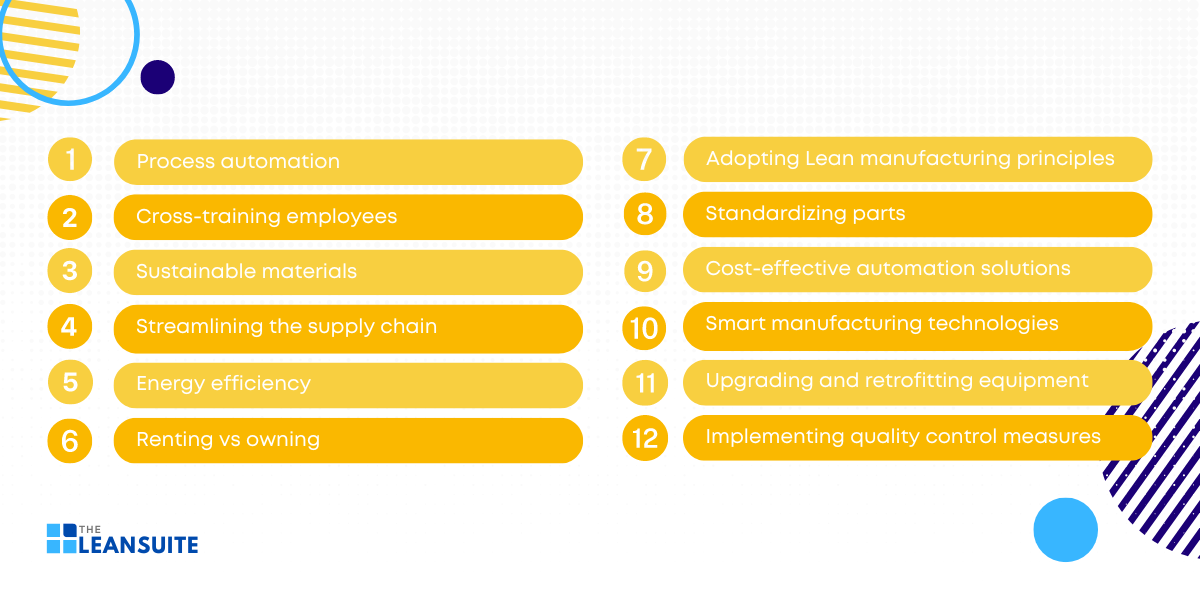In manufacturing, staying ahead often means keeping a close eye on your expenses. From raw materials and labor costs to machinery maintenance and energy consumption, manufacturing businesses face a multitude of financial obligations to ensure their production lines run smoothly. If not managed properly, these costs can quickly spiral out of control, significantly diminishing your profit margins. In this blog post, we’ll explore 12 effective strategies to reduce manufacturing costs, helping you streamline operations, enhance efficiency, and ultimately boost your bottom line.
Understanding manufacturing costs
Manufacturing costs play an important role in determining the overall profitability and efficiency of a production process. So, identifying and meticulously tracking direct material costs, direct labor costs, and overhead costs is essential for any business aiming to maintain a competitive edge.
Direct material costs involve the raw materials directly used in creating a product, while direct labor costs refers to the wages of workers who are directly involved in the production. Overhead costs, on the other hand, encompass all the indirect expenses necessary for production. For example, utilities, rent, and maintenance.
A comprehensive understanding of both direct and indirect costs allows businesses to accurately price their products, control expenses, and optimize their operations. By thoroughly analyzing these costs, you can make informed decisions on budgeting, resource allocation, and strategic planning. Ultimately, this enhances your profitability and sustainability in the market.
How to reduce manufacturing costs
Reducing costs while maintaining high-quality output is a constant challenge that manufacturing businesses must navigate to remain competitive.
In this section, we’ll explore several strategies across six main categories that can significantly reduce manufacturing costs. By optimizing labor costs, minimizing material expenses, controlling overhead, improving manufacturing processes, leveraging technology, and enhancing quality control and assurance, manufacturers can achieve greater efficiency and profitability.
Each category offers practical and actionable strategies that you can implement to streamline operations and drive cost savings.

Optimizing labor costs
Labor costs in manufacturing consist of wages, benefits, and other expenses related to employing workers who operate machinery, assemble products, and perform various tasks essential to the production process.
By optimizing labor costs you can significantly reduce manufacturing costs. This optimization not only enhances productivity, but also ensures that resources are utilized more effectively. A couple strategies to optimize labor costs include:
- Process automation
- Cross-training of employees
1. Process automation: Streamlining tasks and reducing labor hours
Process automation plays a crucial role in optimizing labor costs by minimizing the need for manual labor and increasing operational efficiency. By automating repetitive and mundane tasks, businesses can reduce the number of hours employees spend on these activities. Thereby, lowering overall labor expenses. This strategic shift allows employees to focus on more complex and value-added tasks that require creativity, critical thinking, and problem-solving skills.
2. Cross-training employees: Increasing efficiency and productivity
Cross-training employees on different machines and processes can enhance operational flexibility and minimize the reliance on specialized workers. Thereby, optimizing labor costs and reducing overall manufacturing expenses.
By equipping employees with a diverse skill set, companies can more efficiently manage workforce allocation, swiftly addressing production bottlenecks and adapting to varying demands without the need for additional hires. This approach not only lowers costs but also fosters a more resilient and versatile workforce.
Minimizing material costs
Material costs refer to the expenses incurred by manufacturers for the raw materials and components needed to produce their goods. What’s more, it’s a crucial aspect where manufacturers can achieve significant savings while still upholding high-quality standards. You can reduce manufacturing costs without compromising the integrity of your products by:
- Using sustainable materials
- Streamlining the supply chain
3. Sustainable materials: Reducing waste and environmental impact
Minimizing material costs by adopting sustainable manufacturing practices like using sustainable materials offers a multifaceted approach to help you reduce manufacturing costs, while simultaneously enhancing brand image.
Integrating sustainable materials like recycled or biodegradable resources in production can lower costs, attract eco-conscious consumers, and enhance market position. Additionally, it reduces waste, cutting disposal expenses and environmental impact.
4. Streamlining the supply chain: Efficient sourcing and procurement
Streamlining the supply chain is another way to minimize material costs.
By identifying and eliminating inefficiencies in the supply chain, you can reduce the time and expenses involved in procuring raw materials. This process involves analyzing every step of the supply chain, from supplier selection and inventory management to transportation and delivery.
By optimizing these elements, you can avoid unnecessary delays and excess costs associated with overstocking or stock-outs. Ultimately, a well-streamlined supply chain can reduce lead times, improve efficiency, and reduce costs.
Controlling overhead costs
Control overhead costs refer to the indirect expenses associated with the general operation of a business, such as utilities and rent. These costs often get overlooked when calculating the cost of goods manufactured because they are not directly tied to production. However, it is crucial to evaluate them occasionally as they can cut a lot into your revenue and affect overall profitability. Thus, when looking to control overheads to reduce your overall manufacturing costs, you should consider:
- Improving energy efficiency
- Renting or owning
5. Energy efficiency: Reducing energy consumption and costs
Investing in energy-efficient equipment and lighting can significantly reduce overhead and energy costs while also improving environmental impact.
By upgrading to modern, energy-efficient machinery and lighting systems, you can decrease the amount of energy required to operate. This is because modern equipment uses less energy while maintaining performance. As a result, this leads to lower utility bills and long-term financial savings.
But, beyond the financial benefits, this also supports sustainability by reducing carbon footprint and environmental harm.
6. Renting vs. owning: Weighing the costs and benefits
Renting equipment can also reduce manufacturing overhead by eliminating the high costs associated with maintenance, repair, and depreciation.
When you opt to rent instead of purchase, you transfer the responsibility of upkeep and obsolescence to the rental provider. Thereby, conserving capital and reducing financial risk.
Additionally, renting offers unparalleled flexibility, allowing you to scale their operations up or down in response to market demands without incurring sunk costs. This adaptability ensures that resources are allocated efficiently, enhancing operational agility and financial stability.
Improving the manufacturing process
Manufacturing is a complex and extensive operation, often involving significant costs due to labor, materials, machinery, and overhead. However, by adopting Lean principles and standardizing parts, you can streamline your manufacturing process and reduce these expenses.
7. Adopting Lean manufacturing principles: Eliminating waste and increasing efficiency
In Lean process management, or also known as Lean manufacturing, waste is defined as any activity that does not add value to the customer. The acronym DOWNTIME helps identify the eight types of waste: defects, overproduction, waiting, non-utilized talent, transportation, inventory, motion, and excess processing.
Implementing lean manufacturing principles can systematically reduce these wastes, leading to significant cost savings. This is achieved by cutting production throughput times, boosting labor productivity, reducing excess inventories, and eliminating errors and scrap.
8. Standardizing parts: Reducing complexity and production costs
Standardizing parts is essential for the success of mass customization and build-to-order strategies. This is because it significantly reduces the variety of part types needed in production.
By using standardized components, you can streamline the assembly process, making it more efficient and reducing the complexity of inventory management. This standardization simplifies the integration of parts into various products. As a result, this enhances flexibility and responsiveness to specific customer demands, all while maintaining cost-effectiveness.
Leveraging technology and automation
The rise of digital transformation has revolutionized the manufacturing industry. By implementing cost-effective automation solutions and smart manufacturing technologies, not only can you streamline operations, but you can also reduce manufacturing costs.
9. Cost-effective automation solutions: Increasing efficiency and reducing labor costs
Implementing cost-effective automation solutions can reduce labor costs and enhance operational efficiency by streamlining repetitive and time-consuming tasks.
By integrating technologies such as robotic process automation (RPA), artificial intelligence (AI), and machine learning (ML) into your workflows, businesses can ensure that mundane tasks are executed with precision and speed. Therefore, freeing up human workers to focus on more strategic activities.
Additionally, automation can enhance product quality and reduce defects by maintaining consistent production standards and minimizing human error. Automated systems can perform real-time quality checks and adjustments, ensuring that each product meets the required specifications and standards.
10. Smart manufacturing technologies: Optimizing production and reducing manufacturing costs
Implementing smart manufacturing technologies can revolutionize production processes by optimizing efficiency and reducing manufacturing costs.
By integrating advanced sensors, IoT devices, and AI-driven analytics, manufacturers can gain real-time insights into their operations. This allows for precise control and swift adjustments. What’s more, this heightened level of monitoring and automation not only streamlines workflows, but also enhances product quality and minimizes defects.
Enhancing quality control and assurance
Accurate quality control and assurance are critical in reducing manufacturing costs because they ensure that products meet specific standards and specifications before reaching the consumer.
By identifying and rectifying defects early in the production process, you can avoid the financial losses associated with recalls, returns, and rework. This proactive approach not only minimizes waste and optimizes resource utilization, but also enhances customer satisfaction and brand reputation.
In short, effective quality control and assurance systems streamline operations, reduce variability, and improve efficiency. Ultimately, leading to lower production costs and higher profitability.
11. Upgrading and retrofitting equipment: Increasing efficiency and reducing defects
Upgrading and retrofitting equipment is a great way to enhance product quality and operational efficiency while simultaneously lowering manufacturing costs.
By modernizing machinery with the latest technology, this ensures more precise and reliable manufacturing processes. This, in turn, reduces the likelihood of defects and inconsistencies in the final product.
Advanced equipment often incorporates automation and smart systems that monitor performance in real-time. This allows for swift adjustments and minimizing waste. Additionally, retrofitting existing equipment can extend its lifespan and improve energy efficiency, leading to substantial cost savings on maintenance and energy consumption.
12. Implementing quality control measures: Reducing waste and production costs
Implementing quality control measures is a strategic approach that can significantly reduce manufacturing costs and waste. In addition, it can also improve product quality and increase customer satisfaction.
By systematically monitoring and evaluating the production process, businesses can identify defects early, preventing the need for costly rework or scrapping of materials. This not only saves money, but also ensures that resources are used efficiently.
Enhanced product quality is a direct result of these measures, as consistent standards and checks help in maintaining high performance and reliability of the products. When customers receive products that meet or exceed their expectations, their satisfaction and loyalty increase. Consequently, this leads to repeat business and positive word-of-mouth.





